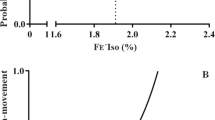Abstract
The effects of two kinds of induction speed of sevoflurane anesthesia on the EEG pattern were compared in the same individual using medical student volunteers: a first exposure of 4% was given, followed after full recovery, by incremental doses of 1, 2 and 4% successively, each being administered for 10 min. The arterial blood level of the anesthetic was measured using gaschrornatograph. The changes of EEG pattern during fast induction with 4% were not represented by the abbreviation of those observed during the slow induction with the incremental doses. The administration of 4% induced a sudden appearance of high voltage, rhythmic slow waves of 2–3 Hz at 1–3 min when the arterial blood anesthetic level increased maximally, which was then followed by a pattern of faster activities of 10—14 Hz mixed with 5–8 Hz slow waves. In contrast, the administration of incremental doses induced an increase in frequency and amplitude of EEG activities in the light plane, followed by their decreases in deeper planes. The final EEG patterns were identical for both these methods of induction. These findings confirmed our previous hypothesis that not only the arterial blood level of anesthetics but the rate of its increase are important factors determining the EEG pattern of anesthesia.
Similar content being viewed by others
References
Gibbs FA, Gibbs EL, Lennox WG: Effect on electroencephalogram of certain drugs which influence nervous activity. Arch Int Med 60: 154–166, 1937
Marshall WH: The effect of anesthesia on the responses central sensory system. Amer J Physiol 123: 140–141, 1938
Beecher HK, McDonough FK: Cortical action potentials during anaesthesia. J Neurophysiol 2: 289–307, 1939
Rubin MA, Freeman H: Brain potential changes in man during cyclopropane anaesthesia. J. Neurophysiol 3: 33–42, 1942
Faulconer AIr, Bickford RG: Electroencephalography in Anesthesiology. Springfield, Ill, Thomas, 1960
Mori K, Shingu K, Mori H, Oshima E, Omatsu Y, Ogawa T: Factors modifying anesthetic-induced EEG activities. Quantitation, Modeling and Control in Anaesthesia. Edited by Stoeckel H. Stuttgart, New York, Georg Thieme, 1985, pp 99–108
Mori H; Dual effect of general anaesthetics on human electroencephalogram. Jap J Anesth 17: 1326–1332, 1968
Mori K, Winters WD: Neural background of sleep and anesthesia. Int Anesth Clin 13: 67–108, 1975
Stevens IE, Oshima E, Mori K: Effects of nitrous oxide on the epileptogenic property of enflurane in cats. Br J Anaesth 55: 145–154, 1983
Mori K, Iwabuchi K, Fujita M: Effects of depolarizing muscle relaxants on the electroencephalogram during halothane anaesthesia in man. Br J Anaesth 45: 604–610, 1973
Oshima E, Shingu K, Mori K: EEG activity during halothane anaesthesia in man. Br J Anaesth 53: 65–72, 1981
Inamoto A, Fujita M, Mori K, Mirna M, Oikawa T: Electroencephalograms of infants and children during general anesthesia. I. Halothane anesthesia. Far East J Anesth 4: 43–55, 1964
Wallin RF, Regan BM, Napoli MD, Stern II: Sevoflurane: a new inhalational anesthetic agent. Anesth Analg 54: 758–766, 1975
Mori K, Iwabuchi K, Kawamata M, Ohta K, Fujita M: The neural mechanism of cyclopropane anesthesia in the rabbit. Anesthesiology 36: 228–237, 1972
Mori K, Mitani H, Fujita M: Epileptogenic properties of diethyl ether on the cat central nervous system. Electroenceph clin Neurophysiol 30: 345–349, 1971
Mori K, Kawamata M, Mitani H, Yamazaki Y, Fujita M:. A neurophysiologic study of ketamine anesthesia in the cat. Anesthesiology 35: 373–383, 1971
Mori K, Avramov MN, Shingu K: Rationale for adding nitrous oxide to the potent anaesthetics. Abstracts. 7th Asian Australasian Congress of Anaesthesiologists, Hong Kong, 1986, pp 26-27
Prince DA, Shanzer S: Effects of anesthetics upon the EEG response to reticular stimulation. Patterns of slow synchrony. Electroenceph clin Neurophysiol 21: 578–588, 1966
Kaada BR, Thomas F, Alnaes E, Wester K: EEG synchronization induced by high frequency midbrain reticular stimulation in anesthetized cats. Electroenceph clin Neurophysiol 22: 220–230, 1967
Mori K, Kawamata M, Miyajima S, Fujita M: The Effects of several anesthetic agents on the neuronal reactive properties of thalamic relay nuclei in the cat. Anesthesiology 36: 550–557, 1972
Seo N, Oshima E, Stevens J, Mori K: The tetraphasic action of lidocaine on CNS electrical activity and behavior in cats. Anesthesiology 57: 451–457, 1982
Kato T, Ikeda K: The minimum alveolar concentration (MAC) of sevoflurane in human. Anesthesiology, in press.
Author information
Authors and Affiliations
Additional information
Dr. Avramov, Visiting Research Fellow from Bulgaria, was supported by the Ministry of Education, Science and Culture, Japan.
Supported in part by a Grant-in-Aid for Scientific Research No. 59440064, from the Ministry of Education, Science and Culture, Japan, and grants by the Niwa Medical Research Foundation and Yanase Memorial Foundation.
About this article
Cite this article
Avramov, M.N., Shingu, K., Omatsu, Y. et al. Effects of different speeds of induction with sevoflurane on the EEG in Man. J Anesth 1, 1–7 (1987). https://doi.org/10.1007/s0054070010001
Received:
Accepted:
Issue Date:
DOI: https://doi.org/10.1007/s0054070010001




